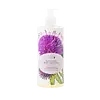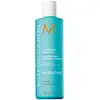What's inside
What's inside
 Key Ingredients
Key Ingredients

 Benefits
Benefits

 Concerns
Concerns

 Ingredients Side-by-side
Ingredients Side-by-side

Aloe Barbadensis Leaf Juice
Skin ConditioningRosa Centifolia Flower Water
Skin ConditioningSulfated Coconut Oil
CleansingGlycerin
HumectantMelia Azadirachta Extract
Skin ConditioningArctium Lappa Root Powder
Skin ConditioningCellulose
AbsorbentTocopherol
AntioxidantPanthenol
Skin ConditioningCamellia Sinensis Leaf Extract
AntimicrobialUrtica Dioica
Rosmarinus Officinalis Flower/Leaf/Stem Water
MaskingCocos Nucifera Oil
MaskingMentha Piperita Leaf Extract
Skin ConditioningSodium Chloride
MaskingOriganum Vulgare Leaf Extract
Skin ConditioningThymus Vulgaris Flower/Leaf Oil
MaskingLonicera Caprifolium Flower Extract
PerfumingEucalyptus Globulus Leaf Oil
PerfumingMelaleuca Alternifolia Leaf Oil
AntioxidantAloe Barbadensis Leaf Juice, Rosa Centifolia Flower Water, Sulfated Coconut Oil, Glycerin, Melia Azadirachta Extract, Arctium Lappa Root Powder, Cellulose, Tocopherol, Panthenol, Camellia Sinensis Leaf Extract, Urtica Dioica, Rosmarinus Officinalis Flower/Leaf/Stem Water, Cocos Nucifera Oil, Mentha Piperita Leaf Extract, Sodium Chloride, Origanum Vulgare Leaf Extract, Thymus Vulgaris Flower/Leaf Oil, Lonicera Caprifolium Flower Extract, Eucalyptus Globulus Leaf Oil, Melaleuca Alternifolia Leaf Oil
Water
Skin ConditioningSodium Lauroyl Sarcosinate
CleansingCocamidopropyl Hydroxysultaine
CleansingCocamidopropyl Betaine
CleansingParfum
MaskingLactamide Mea
HumectantGlycerin
HumectantAcrylates/Palmeth-25 Acrylate Copolymer
Argania Spinosa Kernel Oil
EmollientChondrus Crispus Extract
Skin ConditioningAscophyllum Nodosum Extract
Skin ConditioningLaminaria Saccharina Extract
Skin ProtectingPalmaria Palmata Extract
Skin ProtectingUndaria Pinnatifida Extract
Skin ConditioningXylitylglucoside
HumectantPEG-150 Pentaerythrityl Tetrastearate
EmulsifyingAnhydroxylitol
HumectantSodium PCA
HumectantStyrene/Acrylates Copolymer
PEG-6 Caprylic/Capric Glycerides
EmulsifyingCitric Acid
BufferingLauric Acid
CleansingPolyquaternium-7
Propylene Glycol
HumectantXylitol
HumectantSodium Sarcosinate
Tetrasodium EDTA
Polysorbate 20
EmulsifyingDisodium EDTA
Ethylhexylglycerin
Skin ConditioningPEG-20 Glyceryl Laurate
EmulsifyingGlucose
HumectantTocopherol
AntioxidantLinoleic Acid
CleansingRetinyl Palmitate
Skin ConditioningCaprylic/Capric Triglyceride
MaskingDiethylhexyl Syringylidenemalonate
Skin ProtectingPhenoxyethanol
PreservativeSodium Benzoate
MaskingPotassium Sorbate
PreservativeChlorphenesin
AntimicrobialAlpha-Isomethyl Ionone
PerfumingLinalool
PerfumingHydroxycitronellal
PerfumingWater, Sodium Lauroyl Sarcosinate, Cocamidopropyl Hydroxysultaine, Cocamidopropyl Betaine, Parfum, Lactamide Mea, Glycerin, Acrylates/Palmeth-25 Acrylate Copolymer, Argania Spinosa Kernel Oil, Chondrus Crispus Extract, Ascophyllum Nodosum Extract, Laminaria Saccharina Extract, Palmaria Palmata Extract, Undaria Pinnatifida Extract, Xylitylglucoside, PEG-150 Pentaerythrityl Tetrastearate, Anhydroxylitol, Sodium PCA, Styrene/Acrylates Copolymer, PEG-6 Caprylic/Capric Glycerides, Citric Acid, Lauric Acid, Polyquaternium-7, Propylene Glycol, Xylitol, Sodium Sarcosinate, Tetrasodium EDTA, Polysorbate 20, Disodium EDTA, Ethylhexylglycerin, PEG-20 Glyceryl Laurate, Glucose, Tocopherol, Linoleic Acid, Retinyl Palmitate, Caprylic/Capric Triglyceride, Diethylhexyl Syringylidenemalonate, Phenoxyethanol, Sodium Benzoate, Potassium Sorbate, Chlorphenesin, Alpha-Isomethyl Ionone, Linalool, Hydroxycitronellal
 Reviews
Reviews

Ingredients Explained
These ingredients are found in both products.
Ingredients higher up in an ingredient list are typically present in a larger amount.
Glycerin is already naturally found in your skin. It helps moisturize and protect your skin.
A study from 2016 found glycerin to be more effective as a humectant than AHAs and hyaluronic acid.
As a humectant, it helps the skin stay hydrated by pulling moisture to your skin. The low molecular weight of glycerin allows it to pull moisture into the deeper layers of your skin.
Hydrated skin improves your skin barrier; Your skin barrier helps protect against irritants and bacteria.
Glycerin has also been found to have antimicrobial and antiviral properties. Due to these properties, glycerin is often used in wound and burn treatments.
In cosmetics, glycerin is usually derived from plants such as soybean or palm. However, it can also be sourced from animals, such as tallow or animal fat.
This ingredient is organic, colorless, odorless, and non-toxic.
Glycerin is the name for this ingredient in American English. British English uses Glycerol/Glycerine.
Learn more about GlycerinTocopherol (also known as Vitamin E) is a common antioxidant used to help protect the skin from free-radicals and strengthen the skin barrier. It's also fat soluble - this means our skin is great at absorbing it.
Vitamin E also helps keep your natural skin lipids healthy. Your lipid skin barrier naturally consists of lipids, ceramides, and fatty acids. Vitamin E offers extra protection for your skin’s lipid barrier, keeping your skin healthy and nourished.
Another benefit is a bit of UV protection. Vitamin E helps reduce the damage caused by UVB rays. (It should not replace your sunscreen). Combining it with Vitamin C can decrease sunburned cells and hyperpigmentation after UV exposure.
You might have noticed Vitamin E + C often paired together. This is because it is great at stabilizing Vitamin C. Using the two together helps increase the effectiveness of both ingredients.
There are often claims that Vitamin E can reduce/prevent scarring, but these claims haven't been confirmed by scientific research.
Learn more about Tocopherol